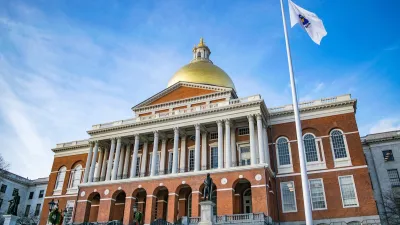In need of an underground overhaul, the Capital Beltway exemplifies the deteriorating conditions of 1/3 of the nation's roadways.
The Capital Beltway, like many of the nation's roads built more than 50 years ago, is in a state of invisible disrepair. Beyond just a surface facelift, it needs underground repairs, which would require tearing out several lanes at once and working during night hours to avoid rush hour traffic. Nearly 2/3 of the Beltway's 64 miles are in Maryland, which recently passed a transportation bill.
According to the American Society of Civil Engineers, the U.S. needs to spend an average of $250 more per person per year to provide long-term fixes to the nation's crumbling roadways, nearly a third of which need immediate attention.
To make up for the federal government's foray into austerity, states have adopted transportation plans that include gas and sales tax increases. They will need to triple transportation spending in order to bring roads up to date, writes Ashley Halsey III.
But is repairing the tens of thousands of roadways nearing the end of their life spans the best use of increasingly scarce transportation funds?
FULL STORY: Beneath the Surface, the Beltway Crumbles

Planetizen Federal Action Tracker
A weekly monitor of how Trump’s orders and actions are impacting planners and planning in America.

Restaurant Patios Were a Pandemic Win — Why Were They so Hard to Keep?
Social distancing requirements and changes in travel patterns prompted cities to pilot new uses for street and sidewalk space. Then it got complicated.

Map: Where Senate Republicans Want to Sell Your Public Lands
For public land advocates, the Senate Republicans’ proposal to sell millions of acres of public land in the West is “the biggest fight of their careers.”

Maui's Vacation Rental Debate Turns Ugly
Verbal attacks, misinformation campaigns and fistfights plague a high-stakes debate to convert thousands of vacation rentals into long-term housing.

San Francisco Suspends Traffic Calming Amidst Record Deaths
Citing “a challenging fiscal landscape,” the city will cease the program on the heels of 42 traffic deaths, including 24 pedestrians.

California Homeless Arrests, Citations Spike After Ruling
An investigation reveals that anti-homeless actions increased up to 500% after Grants Pass v. Johnson — even in cities claiming no policy change.
Urban Design for Planners 1: Software Tools
This six-course series explores essential urban design concepts using open source software and equips planners with the tools they need to participate fully in the urban design process.
Planning for Universal Design
Learn the tools for implementing Universal Design in planning regulations.
Heyer Gruel & Associates PA
JM Goldson LLC
Custer County Colorado
City of Camden Redevelopment Agency
City of Astoria
Transportation Research & Education Center (TREC) at Portland State University
Camden Redevelopment Agency
City of Claremont
Municipality of Princeton (NJ)



























